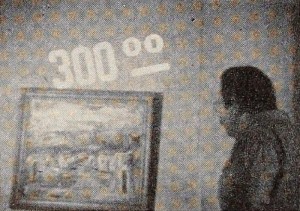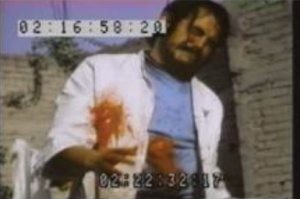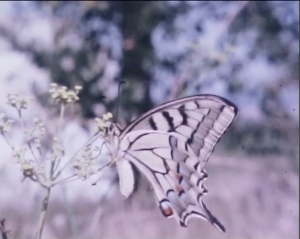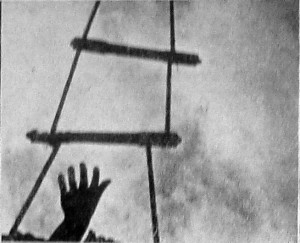
"In Paintings, George E. Canning has hung his story on a simple plot that serves to display an artist's works. A lady makes an appointment with the artist with the intent of making a purchase. The artist, beset by a pile of bills, wonders what he should charge or hope to get; and here figures expressing his thoughts are cleverly superimposed on the scenes of action. The paintings are interesting in themselves for their variety of subject matter and style (this fact rather belies the artist's penury), and the interior lighting throughout the film is excellent. The artist (John S. Arhorn) is well played by himself, the lady by Julia Canning. One could wish that the plot's denouement is not so readily anticipated." Movie Makers, Dec. 1952, 340.

"El paletero cuenta la historia de un vendedor de helados y paletas (Héctor Suárez) que recorre las calles de la ciudad. Es simpático: juega volados con los niños, conversa amistosamente con una criada que ha salido a la calle para hacer el mandado (July Furlong). De pronto un grupo de policías judiciales, vestidos de civil, deciden acosarlo. Se acercan intimidantes a la pareja. Rompen los conos de galletas para helado. El paletero siente pánico y huye por las calles de la ciudad. Es perseguido por los judiciales. Intenta esconderse en las ruinas de una casa abandonada, donde es seguido por uno de los policías. Luchan y el paletero consigue quitarle la pistola. Amenaza al policía y reemprende la huída. Al final encuentra un nuevo escondite en una vecindad. Presa del pánico, el paletero dispara sobre sus perseguidores, hiriendo a dos. Los policías lo ejecutan, y de paso matan a un niño que jugaba en el patio de la vecindad y que había quedado situado en medio del tiroteo" (Vázquez Mantecón, 2012).
El paletero [The popsicle man] tells the story of an ice cream and popsicles seller that goes around the city streets. He is nice: he plays coin toss with children, talks kindly with a maid that has left the house to run some errands. Suddenly a group of policemen, dressed as civilians, decide to harass him. They approach the couple in an intimidating manner. They break the ice cream cones. The popsicle man feels panic and runs away through the city streets. He is chased by policemen. He tries to hide in the ruins of an abandoned house, where he is followed by one of the policemen. They fight and the popsicle man takes his gun. He threatens the policeman and starts running away again. At the end he finds a new hiding spot in a vicinity. Overcome by panic, the popsicle man shoots wounding his persecutors. The policemen execute him, and they also kill a child of the neighborhood that was caught up between the shooting" (Vázquez Mantecón, 2012).
"last month was a notable one, as the first complete showing of “Panshine Pansy” was given. This is our most ambitious film yet, and was claimed by those who saw it as the club’s finest effort. We have yet to make a few additional “cuts” before we are completely satisfied with it… Production started about a year ago and shooting finished during last summer. S. Ellie Powell, who directed, also wrote the scenario, which is a burlesque on the famous Gainsborough picture “Sunshine Susie” (HMHT 1934: 327).
"Awards for a film and a radio program have been won by the communications division of the U.B.C. extension department. The film, entitled 'Paperchase,' was made by students at the 1959 summer school of communications and received an award as the best amateur film at the 12th annual Canadian Film Awards presentation. The film was praised for 'refreshing imaginative and original use of music and dialogue.' The award is a trophy donated by the Association of Motion Picture Producers and Laboratories of Canada" The U.B.C. Alumni Chronicle, vol. 14 no. 4, Winter, 1960, 32.

Documental sobre el ciclo de vida de la mariposa Papilo Machaón, desde su fase inicial como larva hasta su forma final como mariposa. “En el atardecer, descansan las mariposas esperando al nuevo día para continuar su misión, libando y fecundando flores, manteniendo así el equilibrio ecológico del fascinante mundo de la naturaleza”. (Papilio 1980)
Documentary about the life cycle of the Papilo Machaón, from its initial stage as a larva until its final form as a butterfly. "At sunset, the butterflies rest awaiting the new day to continue their mission, absorbing polen and pollinating flowers, maintaining the fascinating ecological equilibrium of the natural world. (Papilio 1980)

"a sogg. breve" short fiction "Parabola, e La città sogna, regia di Guido Pallaro. Questi due film di Guido Pallaro hanno sopratutto un pregio: la buona volontà che dimostra l'autore, giovanissimo, di raggiungere qualche risultato adoperando tutti i mezzi possibili; passato questo periodo di esuberanza non esente da ingenuità stilistiche ed anche da arditezze ingiustificate, Pallaro potrà fornire opere di maggior impegno e più solida struttura. Nella Citta sogna che comprende i sogni di diversi individui il sogno del bambino ha qualche passaggio notevole, e in Parabola si avverte la ricerca di raggiungere nuovi motivi anche se i risultati non appaiono sempre realizzati con equilibrio." "Parabola, and The City Dreams (La città sogna), directed by Guido Pallaro. These two films of Guido Pallaro have above all one merit: the good will that demonstrates their author, who is very young, to reach here some results using all possible means; having passed this period of exuberance not exempt from stylistic ingenuousness and also from unjustified daring, Pallaro has the capacity to provide works of greater commitment and more solid structure. In The City Dreams, which includes the dreams of various individuals, the dream of the child has some notable passages, and in Parabola one senses the search for new motifs even if the results do not always appear to be realized with balance." — Il Ventuno 26 (Review of the G.U.F. of Venice) March 1935
"Paradise Honolulu: Nobuo Miyaoka, using a Cine Special camera and Kodachrome film, has documented contemporary life in Honolulu as have perhaps few cine cameraists in recent years. The picture is essentially newsreel in style and depends upon titles to convey that which is not clear in the pictorial action. But interest is sustained in the careful selection of subject matter and the manner in which it has been photographed. A highlight is the fine night photography in color of Honolulu's annual lantern parade." American Cinematographer, May. 1951, 190.
Total Pages: 299